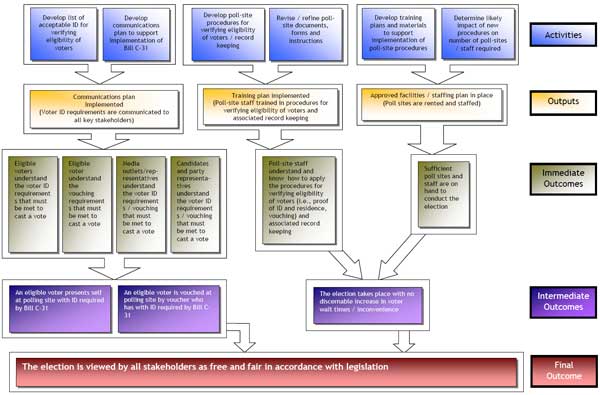Application of the New Voter Identification Procedures under Bill C-31 for the September 17 Federal By-elections in Quebec – Evaluation Synthesis
APPENDIX A
SOURCES USED FOR THE EVALUATION
The findings of this evaluation are based on a number of different sources. These include public opinion surveys with electors and election officers, advertising post-tests, tally sheets of types of identification used by voters that were completed by polling staff at the polls, minutes of a post-mortem meeting with elections officers, analyses of media coverage and analyses of Web site hits.
The analysis of Web site hits did not contribute in a material way to the evaluation. The other sources of information are described in more detail below:
Post-Election Survey of Electors and Election Officers
This study was conducted by Createc+ and consisted of two separate telephone surveys. One was conducted among 2,746 electors in the three electoral districts where by-elections were held: Outremont (n=916), St-Hyacinthe – Bagot (n=915) and Roberval – Lac-St-Jean (n=915). Data collection took place over the period September 18–26, 2007.
The second study is a census conducted among 1,112 elections officers who worked during the September 17 by-elections. Four types of election officers were interviewed: information officers (n=134), central poll supervisors (n=107), poll clerks (n=451) and deputy returning officers (n=420).
The data used in the evaluation are drawn from the report entitled Evaluation of New Voter Identification Requirements at the September 17, 2007 Federal By-Elections (Electors and Election Officers), as well as the accompanying data tables.
Advertising Post-Test
This study was conducted by Impact Research and consisted of two telephone surveys, one conducted prior to the by-elections (data collection September 6 – 13, 2007) and one conducted after the by-elections (data collection September 18 – October 2). For each survey, 900 eligible voters were interviewed, split evenly between the three districts.
The data used in the evaluation are drawn from the report entitled Outremont / Roberval Lac-St-Jean / St-Hyacinthe – Bagot / September 17th by-elections – Final Report, as well as the accompanying data tables.
Tally sheets completed by election officers at the polls
As part of the evaluation of the first implementation of voter ID at the polls, poll staff were required to complete tally sheets to provide counts of the different types of identification used by voters to meet the Bill C-31 requirements. These tallies were used in the evaluation.
However, it is important to note that there are indications that the tally sheets were not always filled out properly (or, in some cases, at all) in some polls. This is not surprising – more than half of the poll staff worked in past elections and it is to be expected that implementation of a new (and substantial) reporting requirement would not be entirely problem-free the first time out.
For this reason, the tally sheet counts are not reported in this evaluation in exact form. Rather, approximate percentage results are reported, as it was felt that to report the results in exact form would be to ascribe to the tally sheets a level of precision that is not supported in fact.
Clipping analysis
An analysis of media coverage of the September 17 by-elections was completed by Harley House Consultants Inc. This analysis covered the period July 28 – September 21, 2007 and examined 345 media clips, drawn from both electronic and print media. The data used in the evaluation are drawn from the report entitled Clipping Analysis of By-Election Coverage.
APPENDIX B
LOGIC MODEL USED FOR THE EVALUATION
LOGIC MODEL

